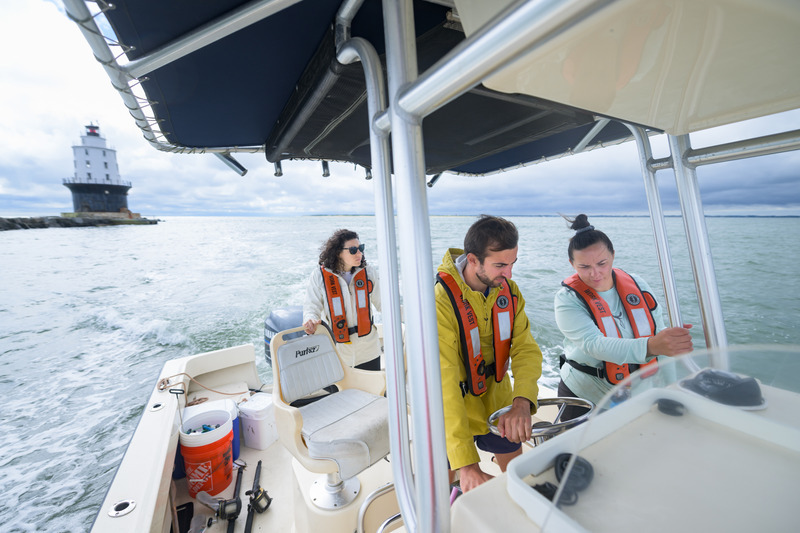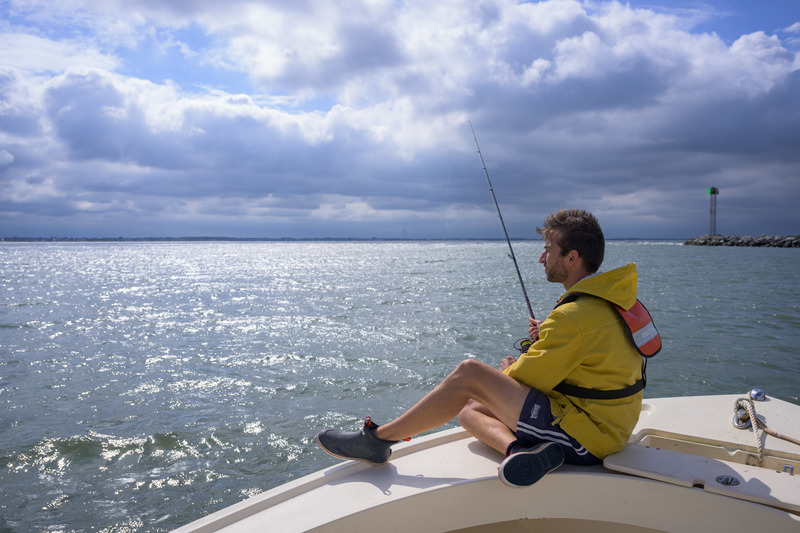


Catch and release
Photos by Evan Krape October 31, 2023
UD researchers look at mortality rate of sharks after they’ve been caught and released by recreational anglers in Delaware Bay
In the state of Delaware, recreational shark fishing is a popular pastime. Anglers are allowed to fish for sharks, and recreational fishing operations routinely offer and actively advertise half- and full-day shark fishing trips in the Delaware Bay. However, anglers are prohibited from keeping or removing from the water any protected species of shark that they might catch while fishing, such as sand tiger and sandbar sharks.
The rule against keeping any protected sharks that are caught is pretty straightforward, but when it comes to accidentally catching a protected species, when an angler puts a hook in the water with a big hunk of bait attached to it, it’s pretty hard to predict what type of fish is going to chomp on the line.
When those anglers do happen to catch a protected shark species, they are supposed to immediately release the shark while it is still in the water. While many people assume they’ve done no harm to the animal as long as they release it, studies have shown that is not always the case.
Now, a University of Delaware research team is investigating what exactly happens to these sharks after they are let go by anglers in the Delaware Bay.
The goal is to see how many sharks succumb to their injuries after being caught and to gauge the likelihood that the sharks will survive post-release. They are also trying to get a sense of how different fishing operations handle the sharks when they are caught and if there is anything that could be recommended to anglers that would help the animals have a better chance of survival.

Aaron Carlisle, assistant professor in the School of Marine Science and Policy (SMSP), Ed Hale, assistant professor in SMSP as well as the fisheries and aquaculture specialist for Delaware Sea Grant, and Bethany Brodbeck, a graduate student in Carlisle’s lab, are conducting the field research for the study. They have been going out with recreational fishing vessels to better understand what happens to sharks when they are caught and released.
Another component to the research is being led by George Parsons, E.I. du Pont Professor at UD’s College of Earth, Ocean and Environment, who is looking at the economic aspect of the study, using survey-based research to value the shark fishery and study anglers’ perceptions and attitudes toward sharks and their management.
Carlisle said the two concurrent studies will be a good way to gauge the biological and economic impacts of the shark fishery in Delaware.
“We want to find out how much money the fishery is actually drawing to the economy,” Carlisle said. “We also want to find out how the fishery is actually impacting the populations of sharks in Delaware, especially the protected ones.”
Helping sharks and local anglers
The researchers pointed out that while they are trying to understand the impact of recreational fishing on sharks in Delaware, that doesn’t mean that they are looking to shut down the fisheries. Rather, they want to get a better understanding of how the fishery is impacting the sharks in order to more effectively manage these species, which, in the long-run, will benefit Delaware’s recreational anglers.
“If we can preserve the shark population, then the fishermen can keep doing what they’re doing for generations,” Brodbeck said. “Ultimately, we want to maintain the shark populations, they want to keep fishing and having a good time doing it, so it’s just about us working together.”
In order to better understand how the sharks react to being caught and released, the research team chartered local fishing boats and caught sharks in the same way that recreational anglers would in a normal setting.

Going out with different charter boat operations allowed them the opportunity to better understand how different charter fishermen are handling the sharks once they are caught, which could ultimately lead to management recommendations based on the different approaches anglers have to handling the sharks.
“We wanted to see if they are doing things differently than we would, is that better or worse, and generally, how are people handling these animals,” Brodbeck said. “We don’t really have a good sense of how much fishing is happening or what kind of fishing is happening so this is a baseline on what is going on in the Delaware recreational shark fishery and then management can figure out from there what is the best thing to do moving forward.”
Stress tests and mobility
Once the sharks are caught, the researchers perform a number of tests to see how the sharks respond to being caught and released.
These tests include taking blood samples to look at bioindicators of stress, which are biological compounds in the blood that can be measured to see how stressed out the shark gets when it is caught.
Carlisle explained that as soon as they get a shark on the line, they start a timer to see how long it takes to get the shark on the boat. They also measure various water quality parameters such as water temperature to see what the environment is like where the shark is caught and understand how environmental conditions may impact stress of fishing on sharks.
In addition, they tag the sharks with multisensor acceleration data loggers, which Carlisle said is basically like a Fitbit for sharks.
These tags provide a high-resolution data set about how the animal is moving, its activity levels and other behavioral metrics such as tail beat frequency.

“We only keep them on for a few days and then they pop off and we have to go find them and recover them to get the data,” Carlisle said.
From the tag, they can learn a lot from the data it recorded — such as how the shark behaved after release and whether or not it survived the encounter.
“Most of these are pretty acute effects so the process of reeling the animal in, bringing them on the boat, the handling, removing the hook, all of that is causing a lot of stress,” Brodbeck said. “Sometimes, it reaches a point where they can’t handle it anymore and that’s when they don’t make it.”
Management recommendations
This is perhaps the most challenging aspect of the study, as Carlisle explained it goes against what they usually try to do when they go out to catch sharks.
“Most of the time, when we’re doing this for other scientific purposes, we want the animals to be happy and healthy so we’ll do everything we can to minimize stress,” Carlisle said. “But this is the kind of thing that we need to learn and this information is incredibly important for management.”
These post-release mortality values will be used in stock assessments which is what state and federal agencies use to say how many animals can be removed from a population in a given year.
“These numbers get directly transferred, plugged into stock assessment models and will have direct implications for management,” Carlisle said. “We get to ask some basic science questions but also provide information to fisheries managers to improve management of that resource.”
Contact Us
Have a UDaily story idea?
Contact us at ocm@udel.edu
Members of the press
Contact us at 302-831-NEWS or visit the Media Relations website

